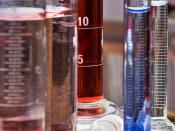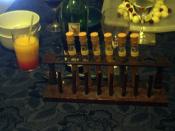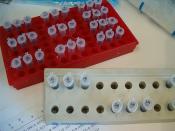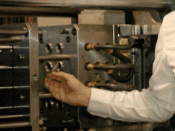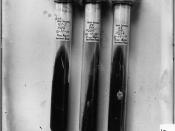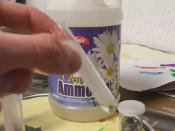Chemicals:àCalcium Carbonate (CaCO3) (2g)à2M Hydrochloric Acid Solution (HCl) (20ml)àDistilled Water (H2O) (100ml)àLimewater Solution [Ca(OH)2] (10ml)]Apparatus:àTest tubes (2)àTest tube fitted with gas delivery tubingàScalesàPlastic spoonàSmall, plastic containeràSmall beakeràSmall candleàTest tube stoppers (2)àBox of matchesàTest tube rackàStand and clampàMeasuring cylinders (50ml and 20ml)àProtective eyewearàProtective glovesàLab coatsàPaperàLong wooden sticks7.1 Isolation of carbon dioxideThe following experiment was performed in a laboratory where the conditions were presumed to be Standard Laboratory Conditions (1 atm. and 25úC). The procedure itself was derived from the procedure stated on page 153 of the Chemistry Laboratory Manual8 and then manipulated to satisfy my specific desires. The reaction between hydrochloric acid and calcium carbonate is as follows:2HCl (aq) + CaCO3 (s) â CaCl2 (aq) + H2O (l) + CO2 (g)1.)Protective eyewear, plastic gloves and a lab coat were worn.
2.)All the glassware and equipment was rinsed with distilled water.
3.)The gas generating equipment was setup to collect carbon dioxide by the upward displacement of air as shown in Appendix A.
4.)2 grams of calcium carbonate was measured using the small plastic lid and the scales and then placed into the reaction tube.
5.)20 millilitres of the 2M hydrochloric acid solution was measured using the 50ml measuring cylinder.
6.)10 millilitres of this solution was placed into the reaction tube and then the stopper assembly was instantly replaced.
7.)When the reaction began to cease, a stopper was placed on the test tube containing carbon dioxide.
8.)Another test tube was then placed at the end of the gas delivery tubing.
9.) The remaining hydrochloric acid solution was then poured into the reaction tube.
10.) Once the reaction ceased the second test tube containing carbon dioxide was sealed off with astopper.
Upon completion of these steps we had two test tubes containing carbon dioxide.
7.2 Demonstrating carbon dioxideÃÂs physical propertiesThe physical properties which were demonstrated were carbon dioxideÃÂs inability to support combustion; density exceeding that of airs; lack of colour; and lack of a distinctive odour. These were demonstrated through the following methods.
7.2.1 Inability to support combustion1.)A small candle was placed in the small beaker and was ignited using a lit, wooden stick.
2.)The contents of a test tube were then poured whilst the test tube was held approximately 3cm above the beaker.
3.)The results were observed and noted.
7.2.2 A density greater than airThis was displayed in ÃÂ7.2.1 Inability to support combustion". If carbon dioxide was less dense than air it would have merely diffused into the atmosphere. However ÃÂ as previously seen ÃÂ it descended into the beaker and extinguished the candleÃÂs flame ultimately revealing that its density is greater than that of air. The reason why becomes clear by analysing the main gases which form dry air as well as their respective relative atomic masses and relative molecular masses.
The pie graph attached as a word document reveal that the four main gases which constitute dry air are oxygen, nitrogen, argon and carbon dioxide. Their respective relative atomic masses/relative molecular masses are 16, 14, 40 and 44. This reveals that out of the four gases carbon dioxide is the heaviest thus it has the greatest density and will descend.
7.2.3 Lack of colour1.)The remaining beaker containing carbon dioxide was retrieved.
2.)A piece of paper was then placed behind the test tube.
3.)There was a lack of change in clarity; this revealed that carbon dioxide was colourless.
7.2.4 Lack of a distinctive odour1.)The stopper on the final beaker was removed.
2.)Carbon dioxide was guided towards our nostrils by waving our hands.
3.)The carbon dioxide was smelled and then the stopper was replaced.
7.3 Demonstrating carbon dioxideÃÂs chemical propertiesThe chemical properties which were demonstrated were carbon dioxideÃÂs reactivity with water to form carbonic acid as well as its reactivity with limewater to form a precipitate of calcium carbonate. However, due to the circumstances of the reaction, both of these chemical properties were able to be proven by utilising a single reaction.
7.3.1 Formation of CaCO3 and carbonic acid1.)The 20ml measuring cylinder was filled with 10ml of limewater.
2.)This was poured into the remaining test tube.
3.)The test tube was shook vigorously until a precipitate formed.
4.)The test tube was then placed back into the test tube rack until the precipitate dissolved.
The following test revealed that carbon dioxide reacts with water to form carbonic acid and with limewater to form CaCO3.
Bibliography:Anonymous. (2009). Baking Soda and Vinegar Reactions and Demonstrations. Retrieved September 1, from http://www.apple-cider-vinegar-benefits.com/baking-soda-and-vinegar.htmlSmith, D, Monteath S, Gould M and Smith R. (2008). Chemistry In Use: Book 1. McGraw-Hill Australia Pty Ltd, NSW. p. 128.
Science Teachers' Association of Western Australia (1987). Chemistry Laboratory Manual: For Senior Secondary School. Singapore: Longman Cheshire Pty Limited. Pages 151-154.
